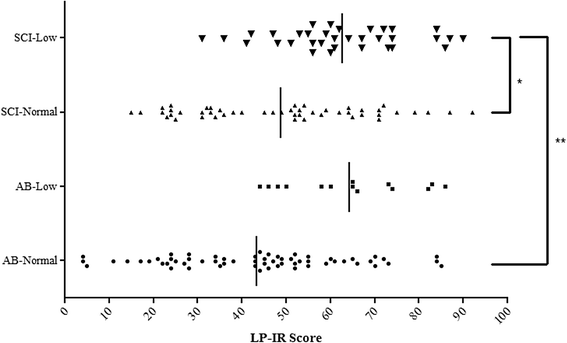Lipoprotein heterogeneity in persons with Spinal Cord Injury: a model of prolonged sitting and restricted physical activity
- PMID: 26215870
- PMCID: PMC4517645
- DOI: 10.1186/s12944-015-0084-4
Lipoprotein heterogeneity in persons with Spinal Cord Injury: a model of prolonged sitting and restricted physical activity
Abstract
Background: Persons with spinal cord injury (SCI) often have low levels of physical activity, which predispose to increased adiposity and decreased high density lipoprotein cholesterol (HDL-C) concentrations, and, generally, normal low density lipoprotein cholesterol (LDL-C) concentrations. In spite of the mixed lipoprotein profile, the SCI population has been reported to have an elevated risk of cardiovascular-related morbidity and mortality. Nuclear magnetic resonance spectroscopy may permit a more precise quantification of lipoprotein particle (P) species, enabling a more accurate inference of risk for cardiovascular disease (CVD) in the SCI population.
Methods: Fasting blood samples were obtained on 83 persons with chronic SCI and 62 able-bodied (AB) subjects. Fasting plasma insulin (FPI), triglycerides (TG), and P number and size of VLDL (very low density lipoprotein), LDL, and HDL subclasses were determined. AB and SCI subjects were stratified based on HDL-C (i.e., Low <40 and Normal ≥ 40 mg/dl): AB-Normal (n = 48), AB-Low (n = 14), SCI-Normal (n = 49), and SCI-Low (n = 34). Factorial analyses of variance were performed to identify group differences in lipoprotein measurements. Pearson correlations were performed between the number of P by lipoprotein subclass, size, FPI, and TG.
Results: The SCI-Normal group was not significantly different from the AB-Normal group for body composition, FPI, TG or LP-IR and had negligible differences in the lipoprotein P profile, except for fewer number and smaller size of HDL-P. The SCI-Low group had a similar lipoprotein profile to that of the AB-Low group, but with a lipid P composition associated with a heightened atherogenic risk and greater tendency toward insulin resistance by the Lipoprotein-Insulin Resistance (LP-IR) score. In the SCI-Low group, the decreased number and reduced size of lipoprotein P were more prevalent and may be associated with increased waist circumference (i.e., abdominal adiposity), relatively elevated TG values (compared to the other subgroups), and an underlying subclinical state of insulin resistance.
Conclusions: Prolonged sitting and restricted physical activity in individuals with SCI had the most profound effect on the HDL-C and its lipoprotein P subclasses, but not on LDL-C, however its P subclasses were also unfavorably affected but not to the same degree. The quantification of lipoprotein P characteristics may be a potent tool for the determination of risk for CVD in persons with SCI.
Figures

Similar articles
-
Effects of insulin resistance and type 2 diabetes on lipoprotein subclass particle size and concentration determined by nuclear magnetic resonance.Diabetes. 2003 Feb;52(2):453-62. doi: 10.2337/diabetes.52.2.453. Diabetes. 2003. PMID: 12540621
-
Effect of functional sympathetic nervous system impairment of the liver and abdominal visceral adipose tissue on circulating triglyceride-rich lipoproteins.PLoS One. 2017 Mar 27;12(3):e0173934. doi: 10.1371/journal.pone.0173934. eCollection 2017. PLoS One. 2017. PMID: 28346471 Free PMC article.
-
Insulin resistance and adiposity influence lipoprotein size and subclass concentrations. Results from the Insulin Resistance Atherosclerosis Study.Metabolism. 2005 Feb;54(2):264-70. doi: 10.1016/j.metabol.2004.09.002. Metabolism. 2005. PMID: 15690322
-
Pathophysiology of Diabetic Dyslipidemia.J Atheroscler Thromb. 2018 Sep 1;25(9):771-782. doi: 10.5551/jat.RV17023. Epub 2018 Jul 12. J Atheroscler Thromb. 2018. PMID: 29998913 Free PMC article. Review.
-
The relationship between high density lipoprotein subclass profile and plasma lipids concentrations.Lipids Health Dis. 2010 Oct 17;9:118. doi: 10.1186/1476-511X-9-118. Lipids Health Dis. 2010. PMID: 20950490 Free PMC article. Review.
Cited by
-
Fenofibrate therapy to lower serum triglyceride concentrations in persons with spinal cord injury: A preliminary analysis of its safety profile.J Spinal Cord Med. 2020 Sep;43(5):704-709. doi: 10.1080/10790268.2019.1581694. Epub 2019 Mar 14. J Spinal Cord Med. 2020. PMID: 30870136 Free PMC article. Review.
-
The Effectiveness of Active Rehabilitation Camp on Physical Performance of Disabled People Moving in Wheelchairs.Int J Environ Res Public Health. 2021 Jul 16;18(14):7572. doi: 10.3390/ijerph18147572. Int J Environ Res Public Health. 2021. PMID: 34300023 Free PMC article.
-
Effects of an Overground Walking Program With a Robotic Exoskeleton on Long-Term Manual Wheelchair Users With a Chronic Spinal Cord Injury: Protocol for a Self-Controlled Interventional Study.JMIR Res Protoc. 2020 Sep 24;9(9):e19251. doi: 10.2196/19251. JMIR Res Protoc. 2020. PMID: 32663160 Free PMC article.
-
Cardiometabolic risk factor clustering in persons with spinal cord injury: A principal component analysis approach.J Spinal Cord Med. 2024 Sep;47(5):627-639. doi: 10.1080/10790268.2023.2215998. Epub 2023 Sep 11. J Spinal Cord Med. 2024. PMID: 37695205 Free PMC article.
-
Diagnosis and Management of Cardiovascular Risk in Individuals With Spinal Cord Injury: A Narrative Review.Circulation. 2023 Jul 18;148(3):268-277. doi: 10.1161/CIRCULATIONAHA.123.064859. Epub 2023 Jul 17. Circulation. 2023. PMID: 37459417 Free PMC article. Review.
References
-
- Otvos JD, Jeyarajah EJ, Bennett DW, Krauss RM. Development of a proton nuclear magnetic resonance spectroscopic method for determining plasma lipoprotein concentrations and subspecies distributions from a single, rapid measurement. Clin Chem. 1992;38:1632–1638. - PubMed
-
- Mackey RH, Greenland P, Goff DC, Jr, Lloyd-Jones D, Sibley CT, Mora S. High-density lipoprotein cholesterol and particle concentrations, carotid atherosclerosis, and coronary events: MESA (Multi-Ethnic Study of Atherosclerosis) J Am Coll Cardiol. 2012;60:508–516. doi: 10.1016/j.jacc.2012.03.060. - DOI - PMC - PubMed
-
- Otvos JD, Collins D, Freedman DS, Shalaurova I, Schaefer EJ, McNamara JR, Bloomfield HE, Robins SJ. Low-density lipoprotein and high-density lipoprotein particle subclasses predict coronary events and are favorably changed by gemfibrozil therapy in the Veterans Affairs High-density Lipoprotein Intervention Trial. Circulation. 2006;113:1556–1563. doi: 10.1161/CIRCULATIONAHA.105.565135. - DOI - PubMed
-
- Centers for Disease Control and Prevention. Physical Activity (http://www.cdc.gov/physicalactivity/); Accessed December 2014.
Publication types
MeSH terms
Substances
LinkOut - more resources
Full Text Sources
Other Literature Sources
Medical
Miscellaneous

